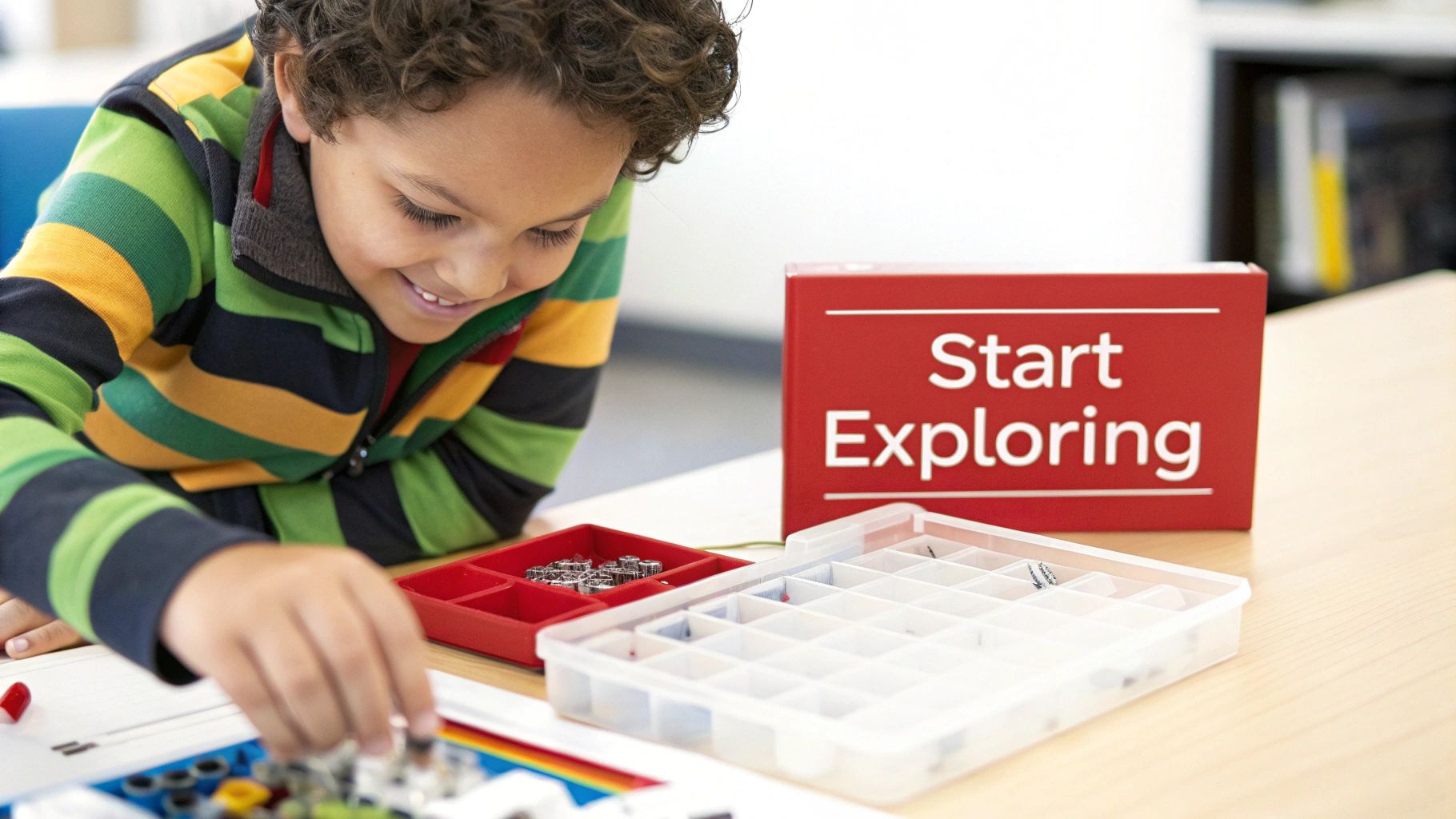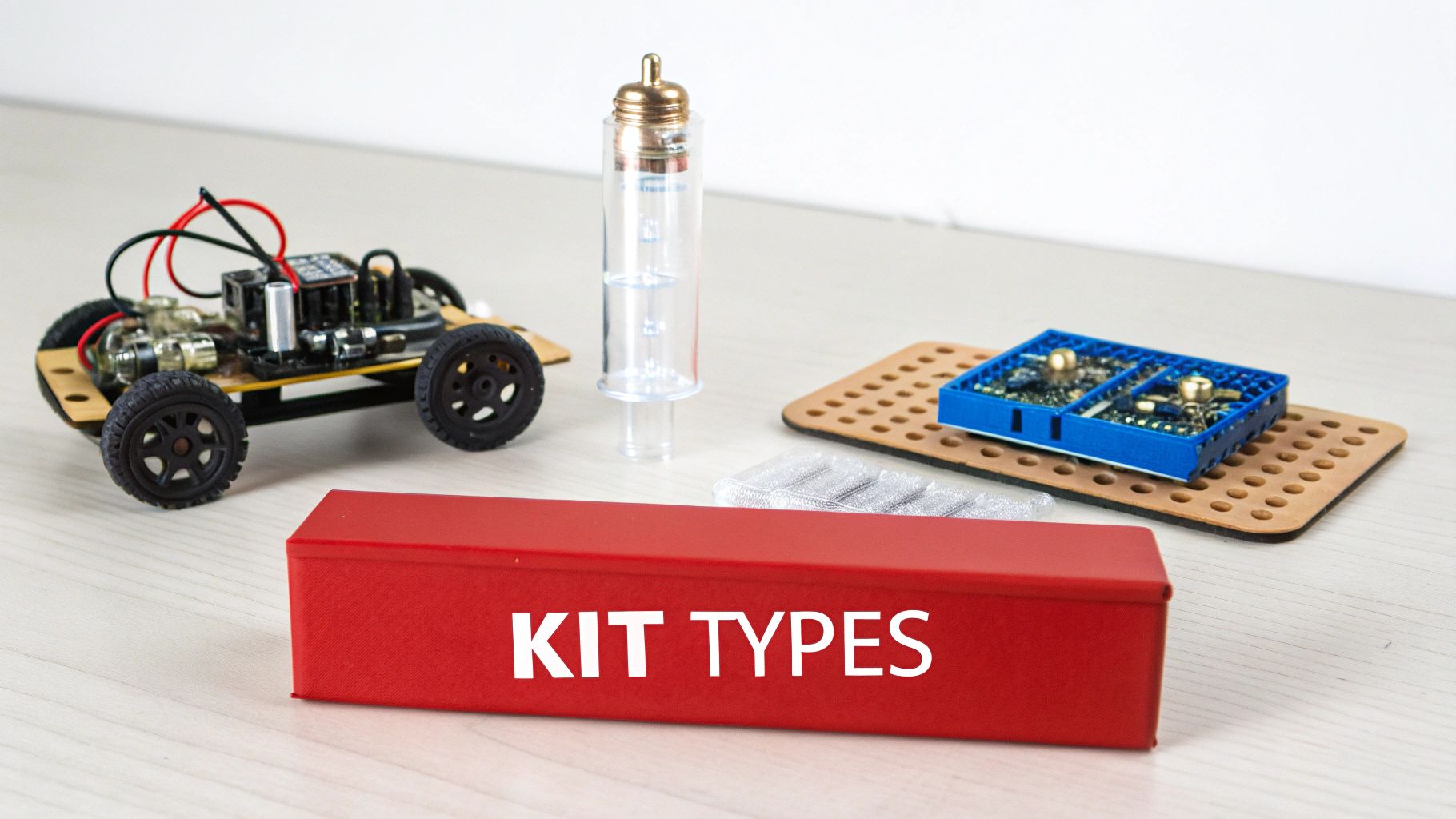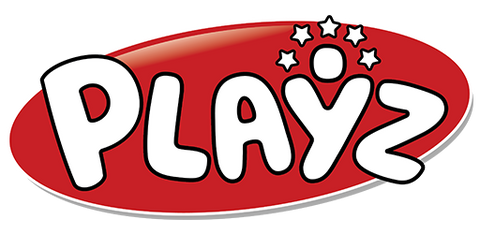
Your Ultimate Guide to Science Fair Project Kits
The science fair sign-up sheet is posted, and the pressure is on. That feeling of overwhelm is common, but the best science fair projects kits are designed to transform that anxiety into a fun, structured learning adventure. Think of them as an all-in-one box, giving your student everything they need to confidently tackle a scientific question from hypothesis to presentation.
Why Science Fair Kits Are the Ultimate Learning Tool

Let's be real—the science fair is more than just another school assignment. It’s a core experience that teaches kids how to be curious, think critically, and solve problems. However, the process of finding a unique idea, hunting down the right materials, and deciphering the scientific method can be a major headache for both students and parents.
This is where a high-quality kit changes the game.
Instead of a last-minute scramble for obscure supplies, these kits offer a clear path to discovery. They are thoughtfully assembled to include everything for a specific experiment—from pre-measured chemicals and labeled wires to detailed, kid-friendly instructions. This allows your student to focus on what truly matters: the learning.
Bridging the Gap Between Theory and Hands-On Fun
At their heart, these kits are catalysts for inquiry-based learning. Instead of just reading about a concept in a textbook, kids get their hands dirty and see science happen right in front of them. It's this hands-on approach that builds a much deeper, more lasting understanding of the scientific method.
There's a reason the global science kits market is booming—it's expected to hit $2.45 billion by 2033 as more parents and educators recognize the power of experiential learning.
Key Takeaway: A science fair project kit isn’t a shortcut; it's a launchpad. It provides the structure, tools, and confidence a student needs to take charge of their own scientific journey.
The Undeniable Pros of Using a Kit
Using a pre-made kit makes the entire science fair process more efficient, educational, and empowering for everyone involved. Here’s a quick breakdown of the pros and cons:
| Pros | Cons |
|---|---|
| ✅ Reduces Prep Stress: No frantic shopping trips for niche materials. | ❌ Less Originality: The core project idea is pre-determined. |
| ✅ Provides a Clear Framework: Step-by-step guides teach the scientific method. | ❌ Limited Scope: Can be hard to expand beyond the kit's parameters. |
| ✅ Builds Genuine Confidence: Successfully completing an experiment is empowering. | |
| ✅ Ensures Reliable Results: Tried-and-true experiments are likely to work. |
By providing a solid foundation, these kits help make the science fair a positive and rewarding experience. You can find a huge variety of awesome science kits out there, designed for all sorts of different interests and age levels.
What to Expect Inside a Science Fair Kit
Opening one of the best science fair project kits is a thrilling experience—it's like unboxing a complete scientific adventure. It’s a perfectly organized recipe box for an experiment where every ingredient and tool is ready to go. This all-in-one approach eliminates the frustrating scavenger hunt for supplies, letting your young scientist dive straight into the fun part: discovery.
The contents are thoughtfully curated to guide a student through the entire scientific process, from forming a hypothesis to presenting the final results. Each component has a specific job, and they all work together to create a smooth, educational journey. It’s this smart structure that transforms a potentially stressful assignment into an engaging, hands-on project.
Unpacking the Core Components
While every kit is a little different, most high-quality options include a similar set of core items. These are the foundational pieces that ensure the experiment is both successful and safe.
Here’s a practical breakdown of what you'll typically find inside:
- Pre-Measured Materials: This is the heart of the kit. It includes all necessary chemicals, powders, wires, seeds, or building components, measured to the exact amounts needed. For example, a crystal kit will have the precise ratio of growing powder to water for optimal results, removing guesswork.
- Specialized Equipment: You’ll also find any specific tools the project calls for, like beakers, test tubes, droppers, a magnifying glass, or electrical components like wires and battery packs.
- Essential Safety Gear: Reputable kits always prioritize safety. Expect to find kid-sized safety goggles and disposable gloves to protect your young scientist while they work their magic.
The All-Important Instruction Manual
You might think the chemicals or gadgets are the main event, but the instruction manual is often the most valuable item in the box. It's not just a boring list of steps; it's a true guidebook for the scientific journey. A great manual explains the why behind each step, not just the how.
For a fantastic example, check out these detailed crystal growing kit instructions. You can immediately see how clear directions make a complex project feel completely achievable.
Actionable Insight: The instruction guide is the project’s roadmap. It translates complex scientific principles into easy-to-follow actions, empowering students to lead their own investigations with confidence and minimal frustration.
The best manuals also include background information on the scientific concepts, prompt questions to encourage critical thinking, and a chart for recording data. Many even provide a template for creating the final presentation board, helping students communicate their findings like a pro.
How to Choose the Right Kit for Your Young Scientist
Not all science fair project kits are created equal. Picking the right one can be the difference between a project that feels like a chore and a genuine learning adventure you'll both remember. The sweet spot is finding a kit that's challenging enough to be engaging but not so difficult that it leads to frustration.
The selection process should focus on three key areas: your child's age, their genuine interests, and the specific rules of the science fair. A first-grader will have a blast with a simple volcano or crystal-growing kit, while a middle schooler might be ready to tackle a basic robotics or electronics project.
Aligning the Kit with Your Child's Passions
This is the most critical factor. A project will only succeed if your child actually cares about it. If your kid is obsessed with gardening, a botany kit will be a much bigger hit than a chemistry set. Tapping into that natural curiosity is the fuel that will power you both through the project.
This is also a great chance to think bigger about educational play. Figuring out what types of activities truly spark joy in your kid can help you pick a winner every time. For more on this, our guide on the benefits of STEM toys for kids has fantastic insights into what makes learning genuinely fun.
Key Takeaway: The best science fair kit isn't the most complex one; it's the one your child is most excited to open. Genuine interest is the catalyst for perseverance, critical thinking, and a positive learning experience.
This visual guide is a great way to walk through the decision, starting with your student's age and passions.

As you can see, what your child is curious about is just as important as their grade level when you're hunting for the perfect project.
Evaluating Practical Considerations
Once you've narrowed it down by interest and age, a few practical questions will help you land on the perfect kit. How much time can you realistically set aside to help? Some kits are designed for independent work, while others require significant adult supervision. Be honest with yourself about your availability.
Also, don't forget to check the science fair rules! Some schools have specific guidelines about using pre-made kits or may even prohibit certain types of experiments. A quick check of the rulebook now can save you a massive headache later.
Science Fair Kit Selection Matrix
This handy comparison table can help you match the right kit to your young scientist's needs and skills.
| Kit Type or Subject | Ideal Age Range | Key Skills Developed | Parental Involvement | Example Project |
|---|---|---|---|---|
| Chemistry | 8-12 | Following instructions, observation, measurement | Moderate | Growing colorful crystals |
| Biology/Botany | 6-11 | Data collection, patience, life cycle knowledge | Low | Observing plant growth under different lights |
| Physics/Engineering | 10-14 | Problem-solving, construction, cause and effect | Moderate to High | Building a simple catapult or electric circuit |
| Robotics/Coding | 12+ | Logic, sequencing, basic programming | High | Assembling and programming a simple robot |
Ultimately, the goal is to find a project that feels like an exciting challenge, not an overwhelming task. This matrix provides a clear starting point for finding that perfect balance.
The Real Educational Value of Using a Project Kit
https://www.youtube.com/embed/kwOH04lZRQM
So, what does a child really learn from using one of these kits? The answer is so much more than a polished presentation board. At their core, these kits are amazing tools for turning abstract ideas—like chemical reactions or electrical circuits—into something real, tangible, and memorable.
Instead of just reading about pH levels in a textbook, a child gets to see the color change with their own eyes. It’s that “aha!” moment that makes the lesson stick.
This is where the learning clicks into place. It’s one thing to memorize the steps of the scientific method, but it's another thing entirely to live it. When an experiment doesn’t go as planned (which often happens!), they learn to think on their feet, troubleshoot, and try a new approach. That process builds resilience and problem-solving skills they will use for life.
For more ideas on getting kids engaged, check out these 10 Hands-On Learning Activities to Engage Students.
From Following Instructions to Building Lifelong Skills
Following a multi-step instruction manual might seem basic, but it’s a critical executive functioning skill. Kits teach kids to read complex directions, focus on details, and work through a problem methodically—the bedrock of any STEM career.
Beyond that, these kits create a perfect, structured environment for data collection. Kids learn to observe, measure carefully, and record their findings, all essential habits for real scientific work. This focus on hands-on learning isn’t just a trend; it’s a proven way to deepen understanding. Our article on the benefits of hands-on learning explores why it works so well.
Key Takeaway: A project kit does more than teach a science concept; it builds a child's "science confidence." Successfully completing a project from start to finish provides a huge sense of accomplishment that can spark a lifelong passion for discovery.
A Growing Recognition of Hands-On Learning
This shift toward active, hands-on learning is a major movement in education. The K-12 laboratory kits market, valued at around $1.2 billion, is projected to hit $2.5 billion by 2033. This boom reflects a growing recognition among schools and parents of how powerful these tools are.
Ultimately, a good science fair project kit is an investment in your child’s curiosity and confidence. It provides the framework to explore, the tools to succeed, and the experience to believe they can solve even the toughest problems.
Exploring Popular Types of Science Fair Kits

The world of science fair project kits is vast, with an adventure waiting for every type of learner. From the classic fizz of a chemistry set to the whirring gears of a robot, the key is to find a kit that gets your child genuinely excited.
Think of it like choosing an after-school activity. You wouldn't push a quiet, artistic kid into a competitive team sport. The same logic applies here: match the kit to your child's personality and existing interests to transform a school assignment into a passion project.
Chemistry and Biology Kits for the Observer
Does your child love mixing, measuring, and watching things transform? A chemistry kit is a perfect fit. These kits make abstract ideas—like pH balance or crystallization—tangible and colorful. They are ideal for methodical thinkers who enjoy following steps to create a little magic.
Biology kits, on the other hand, are for budding naturalists. These projects revolve around observing growth, from plants in a window to a mini-ecosystem in a jar. They teach patience and careful observation, nurturing a love for the natural world.
- Chemistry Example: A crystal-growing kit is a classic for a reason. Kids learn about saturation and molecular structures as they watch stunning geometric shapes form over days.
- Biology Example: A plant germination experiment allows a child to test how different light sources affect a sprouting seed, teaching the basics of photosynthesis in a hands-on way.
Physics and Engineering Kits for the Builder
If your child lives to build, take things apart, and figure out how they work, physics and engineering kits are their playground. These kits are all about action and reaction, letting kids explore concepts like motion, force, and electricity. They are made for tinkerers and problem-solvers who see a pile of parts as a world of possibilities.
Actionable Insight: A well-chosen engineering kit fosters a "builder's mindset." It encourages kids to experiment, fail, and redesign until they achieve their goal, building resilience and critical thinking skills along the way.
The global STEM toys market, which includes most science kits, was valued at $1.20 billion and is expected to hit $1.83 billion by 2030. This growth is driven by the increasing focus on providing kids with practical, tech-focused skills from a young age.
Robotics and Coding Kits for the Innovator
For the tech-savvy kid, robotics kits are an incredible gateway into programming and automation. These advanced kits are a two-for-one deal: kids assemble a machine and then use simple, block-based coding to bring it to life. They are perfect for logical thinkers who get a thrill from seeing on-screen commands translate into real-world action.
Building a robot can sound intimidating, but today's kits are surprisingly user-friendly, with clear instructions and intuitive coding interfaces. These projects do more than just build robots; they build crucial skills in logic, sequencing, and problem-solving that are invaluable in our tech-driven world.
FAQs: Your Top Questions About Science Fair Kits
Choosing a science fair kit can feel like a big decision. You want to ensure you're giving your child the best opportunity for a fun, educational, and successful project. It's normal to have questions, so we've compiled clear, straightforward answers to the most common ones we hear from parents and educators.
Are Science Fair Kits Considered Cheating?
No, using a science fair kit is not cheating. This is a common misconception. A kit is a tool, not a shortcut. It provides the necessary materials and a proven framework, much like a baker uses a recipe. The real scientific work—forming a hypothesis, conducting the experiment, collecting data, analyzing results, and creating the presentation—is all done by the student. The kit simply removes the logistical barrier of sourcing supplies.
How Much Should I Expect to Spend on a Good Kit?
Prices for science fair kits vary based on complexity, component quality, and reusability. Here's a general guide to help you budget:
- Basic Kits ($20 - $40): Perfect for younger kids, these kits typically focus on a single, engaging experiment like erupting a volcano or growing crystals. They offer a great, low-cost introduction to scientific principles.
- Comprehensive Kits ($50 - $100+): Geared toward older students, these kits tackle more advanced subjects like robotics, electronics, or chemistry. They often include high-quality, reusable components that provide a deeper, more extensive learning experience.
What If the Experiment Doesn't Work as Expected?
First, don't panic! An experiment that "fails" is a golden learning opportunity and a core part of the scientific process. Many of history's greatest discoveries began as unexpected results. This is where real critical thinking begins.
Actionable Steps:
- Review the Instructions: Calmly go through the steps together. Was anything missed? Was a measurement slightly off?
- Form a New Hypothesis: If you followed everything correctly, the project can pivot to investigate why it didn't work.
- Troubleshoot: This process of analyzing an unexpected outcome is the heart of the scientific method.
- Check for Support: Many companies offer online help or video tutorials. Use them!
Key Takeaway: An experiment that "fails" is often more valuable than one that works perfectly on the first try. It teaches resilience, problem-solving, and the crucial scientific skill of analyzing unexpected outcomes.
Where Can I Buy High-Quality Science Fair Kits?
To ensure you get a safe, complete, and well-designed kit, purchase from reputable sources. While large online marketplaces are convenient, read recent reviews carefully to verify quality and completeness. Your best bet is often a dedicated educational supply store, museum gift shop, or specialty hobby store. Buying from a trusted retailer like Playz ensures materials are safe, instructions are clear, and all necessary parts are included.
Ready to spark your child's curiosity and make their next science fair project a memorable success? Playz offers a wide variety of engaging, hands-on science kits designed to make learning fun. Explore our collection and find the perfect adventure for your young scientist at https://www.playzusa.com.
